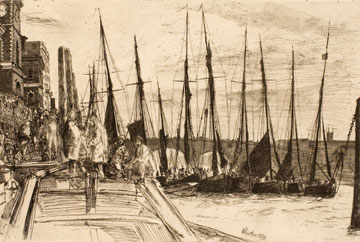

| For more information about this article or gallery, please call the gallery phone number listed in the last line of the article, "For more info..." |
May Issue 2006
Gibbes Museum of Art in Charleston, SC, Offers Works by James McNeill Whistler
 A new
exhibition, James McNeill Whistler Etchings from the Vreede
Collection, will be on view at the Gibbes Museum of Art in
Charleston, SC, from May 26 through Aug. 27, 2006. This extraordinary
collection of 17 etchings is available for public view thanks
to Dr. and Mrs. Anton Vreede's generous donation of the works
of art to the Gibbes. This exhibition will be on view in
a newly revamped gallery (Works on Paper Gallery) at the Museum
that is now designated as a showcase for selections from the Gibbes'
collection of over 4,000 works on paper.
A new
exhibition, James McNeill Whistler Etchings from the Vreede
Collection, will be on view at the Gibbes Museum of Art in
Charleston, SC, from May 26 through Aug. 27, 2006. This extraordinary
collection of 17 etchings is available for public view thanks
to Dr. and Mrs. Anton Vreede's generous donation of the works
of art to the Gibbes. This exhibition will be on view in
a newly revamped gallery (Works on Paper Gallery) at the Museum
that is now designated as a showcase for selections from the Gibbes'
collection of over 4,000 works on paper.
Born in Lowell, MA, James McNeill Whistler (1843 - 1903) grew
up partly in St. Petersburg, Russia, where he attended drawing
classes and visited the imperial collections. He received his
formal education at the United States Military Academy at West
Point before moving to Europe permanently in 1855. Initially settling
in Paris, he entered the Acadmie Gleyre where he became a devotee
of the cult of the Japanese print and other Asian art forms. Henri
Fantin-Latour became a close friend and through him Whistler was
introduced to Gustave Courbet. Like many of the French avant-garde
artists of the day Whistler was influenced by Courbet's realism
and by the seventeenth-century Dutch and Spanish schools.
At first Whistler gave priority to etching, a technique he had learned before leaving the United States. He created a series of prints known as the French Set, dated 1858, that demonstrates his indebtedness to the Dutch masters. However, his first major painting At the Piano (1858-59, Cincinnati, Taft) was rejected by the 1859 Salon and Whistler promptly moved to London.
Developing a reputation as a flamboyant personality,
his painting career was launched with a favorable reception at
the 1860 exhibition of the Royal Academy. At the same time he
began work on a series of etchings known as the Thames Set that
combines his interest in realism with the Japanese aesthetic.
Whistler achieved international notoriety with the rejection of
Symphony No. 1, The White Girl (1862, Washington, DC, National)
from both the Royal Academy and the Salon. It became a major attraction
at the 1863 Salon des Refuss. However in 1877 his career
suffered a serious setback when critic John Ruskin denounced him
for his work entitled Nocturne in Black and Gold: The
Falling Rocket (1875, The Detroit Institute of Arts). Whistler
sued him for libel and won, but received little monetary reward
and was left bankrupt. At the same time he lost the patronage
of his major client Frederick Leyland who disapproved of Whistler's
design for the dining room of his London home. The Peacock
Room, or Harmony in Blue and Gold (1876-77, Freer Gallery
of Art), exerted a strong influence on interior design concepts
of the Art Nouveau style.
Returning to etching in order to rebuild his financial assets, Whistler traveled to Venice where he executed a set of etchings from 1879 80. By 1890 he was back in London having reestablished his reputation as an artist of international stature. He was elected president of the International Society of Sculptors, Painters and Gravers, but the death of his wife and his own ill health made him withdraw from an active social life.
In 1903, the year of his death, a memorial exhibition was held in Boston with a subsequent retrospective held by the International Society in London, and the Ecole des Beaux-Arts in Paris.
Throughout his career Whistler worked as an engraver. The Vreede collection includes etchings that represent the full range of his artistic achievement and style in the print medium with an emphasis on images from the Thames Set and his many views of the Netherlands.
Whistler was one of the first American artists to react to the Western dissemination of the Japanese Ukiyo-e print. Through his work many American artists, including those working during the Charleston Renaissance period, learned Eastern aesthetics.
A native of Holland, Dr. Anton Vreede graduated medical school in 1957 after serving 2 years in the Royal Dutch Navy. He immigrated to the United States and moved to Seattle for 3 years before settling in New York. After a 28-year career as a surgeon in Binghamton, NY, Dr. Vreede and his wife Caroline moved to Kiawah Island, SC, in 2004. He began his collection of etchings and lithographs by James Abbot McNeil Whistler in 1982 as a part of his larger collection of works of art by American artists working in the Netherlands. Dr. Vreede generously donated his collection of 26 etchings and lithographs by Whistler to the Gibbes in 2004.
For further info check our SC Institutional
Gallery listings, call the Museum at 843/722-2706 or at (www.gibbesmuseum.org).
Carolina Arts is published monthly by Shoestring Publishing
Company, a subsidiary of PSMG, Inc.
Copyright© 2006 by PSMG, Inc., which published Charleston
Arts from July 1987 - Dec. 1994 and South Carolina Arts
from Jan. 1995 - Dec. 1996. It also publishes Carolina Arts
Online, Copyright© 2006 by PSMG, Inc. All rights reserved
by PSMG, Inc. or by the authors of articles. Reproduction or use
without written permission is strictly prohibited. Carolina
Arts is available throughout North & South Carolina.